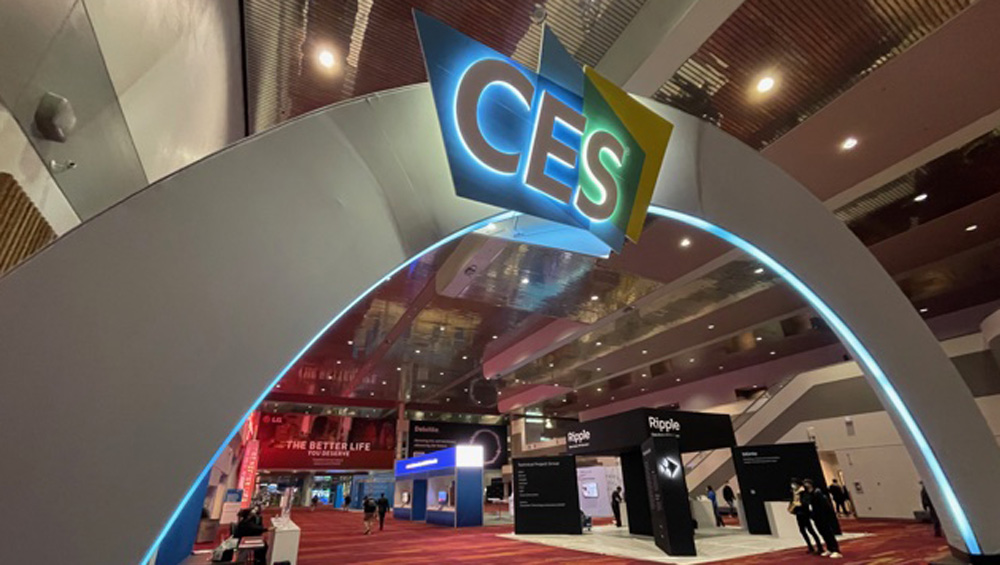
TV Takes Backseat At Auto-Dominated CES ’22

After a one-year absence due to the COVID-19 pandemic, CES returned to Las Vegas this week, making it the first major trade show relevant to the television industry to take place in-person since the last CES was held in January 2020. CES 2022 did so despite a jump in COVID-19 infections worldwide that caused many prospective exhibitors and attendees (including this reporter) to stay home and experience the show virtually, and which also prompted show organizer Consumer Technology Association (CTA) to shorten the show by one day.
This year’s hybrid in-person/virtual event, which will now conclude tomorrow, Jan. 7, instead of Saturday, Jan. 8, certainly doesn’t compare to the giant CES shows of recent years that drew 170,000-180,000 attendees. One CES veteran estimated the crowd to be perhaps 30% of that, but with more international attendees than expected given today’s travel challenges. A CTA spokesperson said only that “tens of thousands” of attendees were in Las Vegas and that final numbers wouldn’t be available until several weeks after the show.
A smaller turnout isn’t surprising given the recent impact of the new omicron variant, which has ramped up COVID-19 infections around the world since first being identified in South Africa in late November 2021. A slew of major players either pulled out of CES 2022 or dramatically scaled down their in-person presence in recent weeks, including T-Mobile, Microsoft, Google and GM, whose CEO Mary Barra gave a virtual keynote yesterday outlining the company’s commitment to electric vehicles (EVs). And COVID-19 was still top of mind in press briefings and keynotes that emphasized how technology has served as a lifeline throughout the pandemic.
“We’ve spent some two years surviving in a virtual world, thanks in large part to incredible tech advancements,” said CTA CEO Gary Shapiro in his ribbon-cutting address Wednesday. “Just imagine where we would have been these last two years without modern technology. No internet, no remote work, no content streaming, no contactless delivery, no telehealth.”
Set Manufacturers Mum On NextGen TV
Some 2,300 exhibitors from 19 different countries still made the trip to Las Vegas, including major TV set manufacturers and CES stalwarts LG, Samsung and Sony. But the tone of these companies’ exhibitions has changed dramatically from two decades ago, when they focused on the latest living room hardware such as new HDTV sets and Blu-ray disc players. In fact, while LG, Samsung and Sony all make ATSC 3.0-compliant, or “NextGen TV,” TV sets and introduced new models in Las Vegas, none of them actually mentioned NextGen TV during their official CES 2022 presentations.
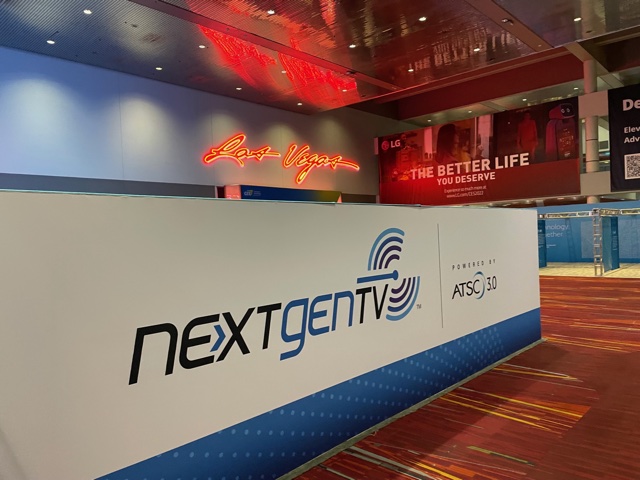 Instead, these consumer electronics giants trumpeted their sustainability efforts as they look to reduce their environmental footprint through manufacturing changes and reduced power consumption in their devices. And they presented their view of a connected smart home that leverages advancements in internet, smartphone and AI technology to link various devices, providing not only better entertainment experiences but a more comfortable life in general.
Instead, these consumer electronics giants trumpeted their sustainability efforts as they look to reduce their environmental footprint through manufacturing changes and reduced power consumption in their devices. And they presented their view of a connected smart home that leverages advancements in internet, smartphone and AI technology to link various devices, providing not only better entertainment experiences but a more comfortable life in general.
In his keynote, Samsung Electronics Vice Chairman-CEO Jong Hee Han described his company’s goal of “sustainable innovation,” embodied by the use of recycled cardboard in its TV boxes and a new TV remote control that uses radio frequencies like Wi-Fi to recharge itself.
And in its virtual press briefing led by CEO William Cho, LG showed how its AI-based digital assistant could seamlessly move playback of a cooking show from a new 97-inch OLED set in the living room to a smaller pedestal-mounted TV (the 27-inch StanbyME) in the kitchen via Wi-Fi networking. It also demonstrated how a smartphone could be used to scan cooking instructions via QR code from a box of frozen lasagna and then automatically program an LG oven to execute them.
Unlike LG and Samsung, Sony doesn’t make home appliances like washing machines, dishwashers and refrigerators in addition to TVs and smartphones. Instead, it owns a movie studio and record label and makes a wide array of professional hardware for TV and movie production, as well as manufacturing the popular Playstation game console. As such, Sony’s press briefing from its booth highlighted Hollywood more than the home.
Sony Chairman-CEO Kenichiro Yoshida described developments in virtual production using Sony’s Crystal LED displays and Venice digital cinema cameras, as well as applications for Sony’s camera-equipped drones and Hawk-Eye sports tracking technology. And Sony Pictures Chairman-CEO Tom Rothman joined Spiderman star Tom Holland to show a clip from Uncharted, an upcoming movie based on a popular Playstation video game. Uncharted is being produced by Playstation Productions, a collaboration between the film studio and its gaming division, Sony Interactive Entertainment, which aims to adapt popular games into movies and TV shows.
Sony is also a longtime technology supplier to the automotive industry, which in recent years has embraced CES as a venue for major technology announcements (like the Chevy Silverado EV pickup GM unveiled yesterday). At CES 2020 the company showed a prototype EV sedan equipped with Sony imaging sensors and cloud-based communications under an initiative called Vision-S. While Sony didn’t say it planned to make the car itself, it did begin road-testing the Vision-S-01 in Europe in late 2020 to evaluate its safety and in-car entertainment systems, which allow the cabin to be personalized to different users. Since then, it has also tested 5G communications to the vehicle with an eye toward future autonomous operation.
At CES this week, Sony upped the EV ante, unveiling a seven-seat SUV prototype, Vision-S 02. And Yoshida said this spring Sony will launch a new company, Sony Mobility Inc., that aims to commercially produce its own EV models.
“Sony Mobility Inc. will harness the potential of mobility, utilizing our AI and robotics,” Yoshida said. “This is a bold step into the future, bringing our expertise in creating diverse and innovative solutions to the world.”
5G Hype Cools Off
While wireless carriers’ new 5G services grabbed headlines during the last few CES editions, the discussion of 5G was much more muted this year. That is largely due to the decision by carriers AT&T and T-Mobile to pull out of the show; T-Mobile CEO Mike Sievert was originally slated to deliver a keynote.
Verizon did have a slick virtual event Tuesday hosted by the actress and producer Elizabeth Banks, in which Verizon CEO Hans Vestberg declared that the industry was “entering the second wave of the 5G era” and that 100 million people would have access to Verizon’s “5G Ultra Wideband” network later this month. Celebrities like ESPN anchor Hannah Storm and actor Terry Crews also made appearances to help explain how 5G smartphones can provide reliable internet access in crowded stadiums and 5G fixed wireless access could serve as a viable alternative for home broadband service.
But the biggest 5G news this week still remains the last-minute agreement by Verizon and AT&T to honor a request from the Federal Aviation Administration to postpone rolling out 5G on newly reclaimed C-band spectrum for two weeks, as the FAA examines the potential impact to airplanes’ navigation systems.
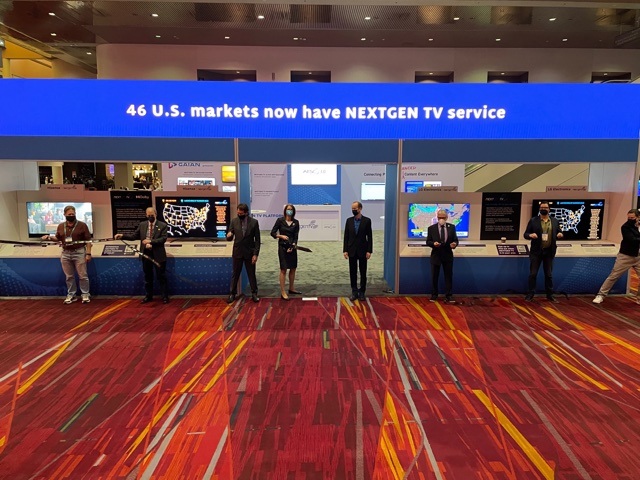 Broadcasters Cite NextGen TV Gains
Broadcasters Cite NextGen TV Gains
The rollout of the NextGen TV standard also didn’t generate the same buzz this year as it did back in 2020, when the first 3.0-capable sets were introduced. But both stations and set-makers have made significant strides in the past two years, which the ATSC is highlighting in a large booth at CES.
Forty-six markets in the U.S. now have NextGen TV service, covering 45% of the U.S. population. In fact, Sinclair Broadcast Group and Nexstar Media Group, partners in the 3.0 joint venture Bitpath, teamed to launch a new market about every two weeks in 2021, said SVP of Advanced Technology Mark Aitken. He attributed the quick progress to a spirit of collaboration across the industry.
“A great deal of that is not only reflective of our commitment to 3.0 but the engagement of a broader and broader community of broadcasters,” Aitken said. “I can tell you that there aren’t a lot of markets where a clean conversion of 3.0 can happen without the participation of multiple broadcasters.”
Set-makers also had a strong 2021 and shipped three million NextGen TV’s, more than tripling CTA’s initial projection of 800,000 sets for last year. CTA is now projecting NextGen TV sales of 4.5 million units in 2022.
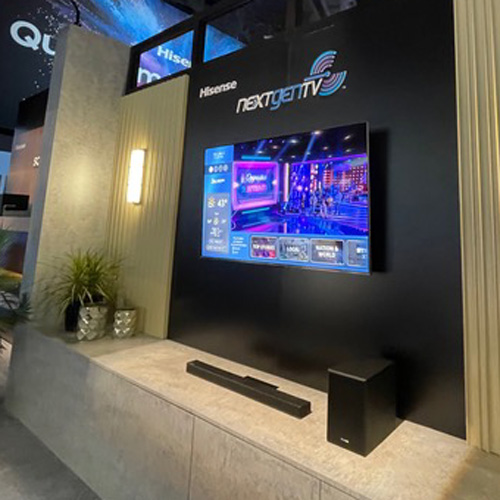
NextGen TV on display in the Hisense booth
Probably the biggest NextGen TV news this week was the announcement by Chinese manufacturer Hisense that it will now incorporate NextGenTV tuners into three of its “ULED” LCD TV set lines (U7H, U8H and U9H) for a total of eight new 3.0-capable models ranging in screen size from 55 to 85 inches. Hisense’s new NextGen TV offerings start with the $800, 55-inch 55U7H, which should be available by mid-summer, and ramp up to the top-of-the-line 75-inch U9H Mini-LED model, will be available by late summer for $3,200.
Hisense has been steadily gaining share in the U.S. in the 65-inch-plus market compared to more expensive competitors. The company sees NextGen TV as another high-end feature it can deliver at an affordable price, said Douglas Kern, senior director product and brand marketing for HiSense USA.
“The newly integrated NextGen TV tuner brings higher quality picture and sound, more content options and upgrades and ensures that the U7H is equipped for the future of broadcast television,” Kern said.
Another intriguing NextGen TV product launch at CES is the latest model from over-the-air DVR specialist Tablo. The Tablo ATSC 3.0 Quad HDMI OTA DVR has four separate 3.0 tuners and connects to an antenna on one end and a NextGenTV on the other in order to record both 1.0 and 3.0 programming. The $300 unit is available for pre-order now and should ship this spring.
The other big receiver news for NextGen TV this week was a test agreement that system-on-a-chip (SoC) vendor MediaTek signed with broadcast coalition Pearl TV to develop a total integrated solution for NextGen TV including an ATSC 3.0 demodulator, a Smart TV system on a chip family that goes from entry-level 4K to premium 8K and a ready-to-go software stack for both Android and Linux. Such a system will enable other TV set manufacturers to launch NextGen TV products more quickly and with lower development costs.
“To really get into the low-volume TV sets you need a player like MediaTek,” said Pearl TV managing director Anne Schelle. “They produce a full solution, and that means a lot for smaller manufacturers, and for manufacturers who might be making accessory devices.”
Auto Still Holds 3.0 Promise
Sony’s automobile initiatives, as well as other software-centric vehicles like GM’s upcoming EVs and autonomous vehicles, may present a future opportunity for U.S. broadcasters. While Yoshida didn’t mention using ATSC 3.0 as a communications path to Sony’s Vision-S EVs, just 5G, a press release accompanying his keynote said that “since updates are reflected in the vehicle via over the air (OTA), it is possible to provide security and evolve service functions and value-added offerings continuously.”
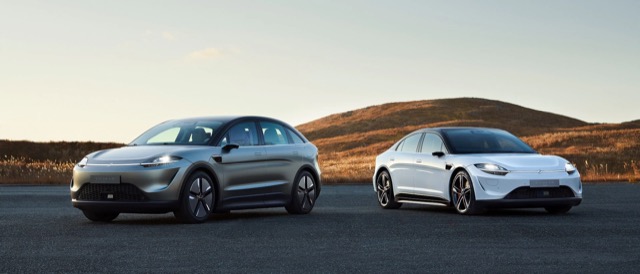
Sony’s Vision-S prototype SUV and sedan
More important, Sony has been intimately involved in testing automotive applications via 3.0 transmission over the past year, using semiconductor technology the company originally developed for use in Japan. At the ATSC conference this summer Sony shared results of successful trials of 3.0 data delivery to automobiles in Phoenix and Santa Barbara, Calif., it conducted in conjunction with broadcast coalition Pearl TV and the News-Press Gazette station group. And at CES this week Sony disclosed it has also conducted successful trials of its “CLOVER” CXD2885 receiver chip on the Motown 3.0 Test Track in Detroit, where several stations have set aside dedicated 3.0 bandwidth for automotive testing.
Successful applications in Detroit included the reception of audio/visual media files at highway speeds and the “hand off” of service between transmitters in separate markets working in tandem.
Schelle said: “Sony’s results prove that transformative advances in core TV broadcast technologies made possible by ATSC 3.0 give terrestrial broadcasters new ways to deliver infotainment and IP data services to an infinite number of vehicles—and the displays and devices in them — simultaneously, whether on the go or in the garage.”
































Comments (0)